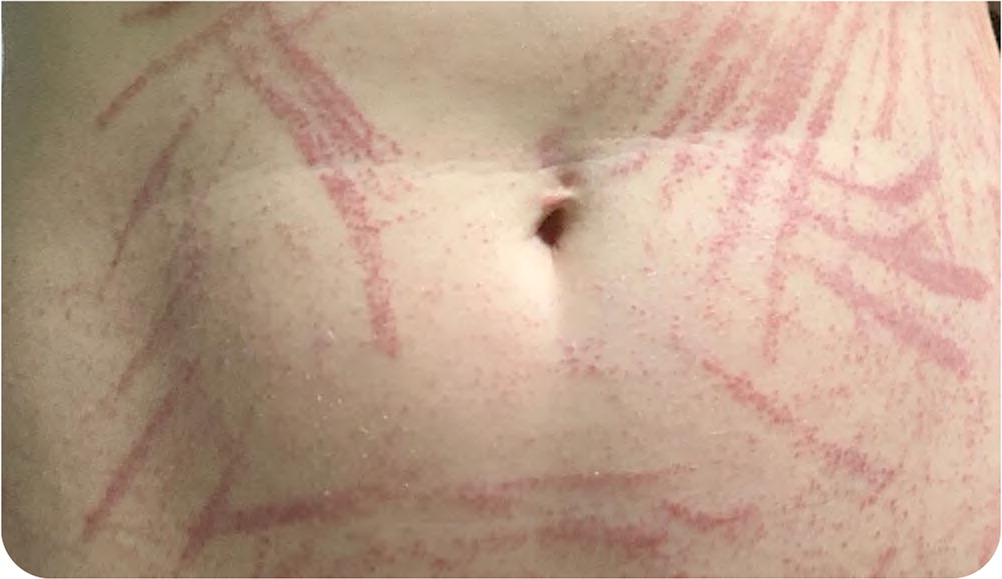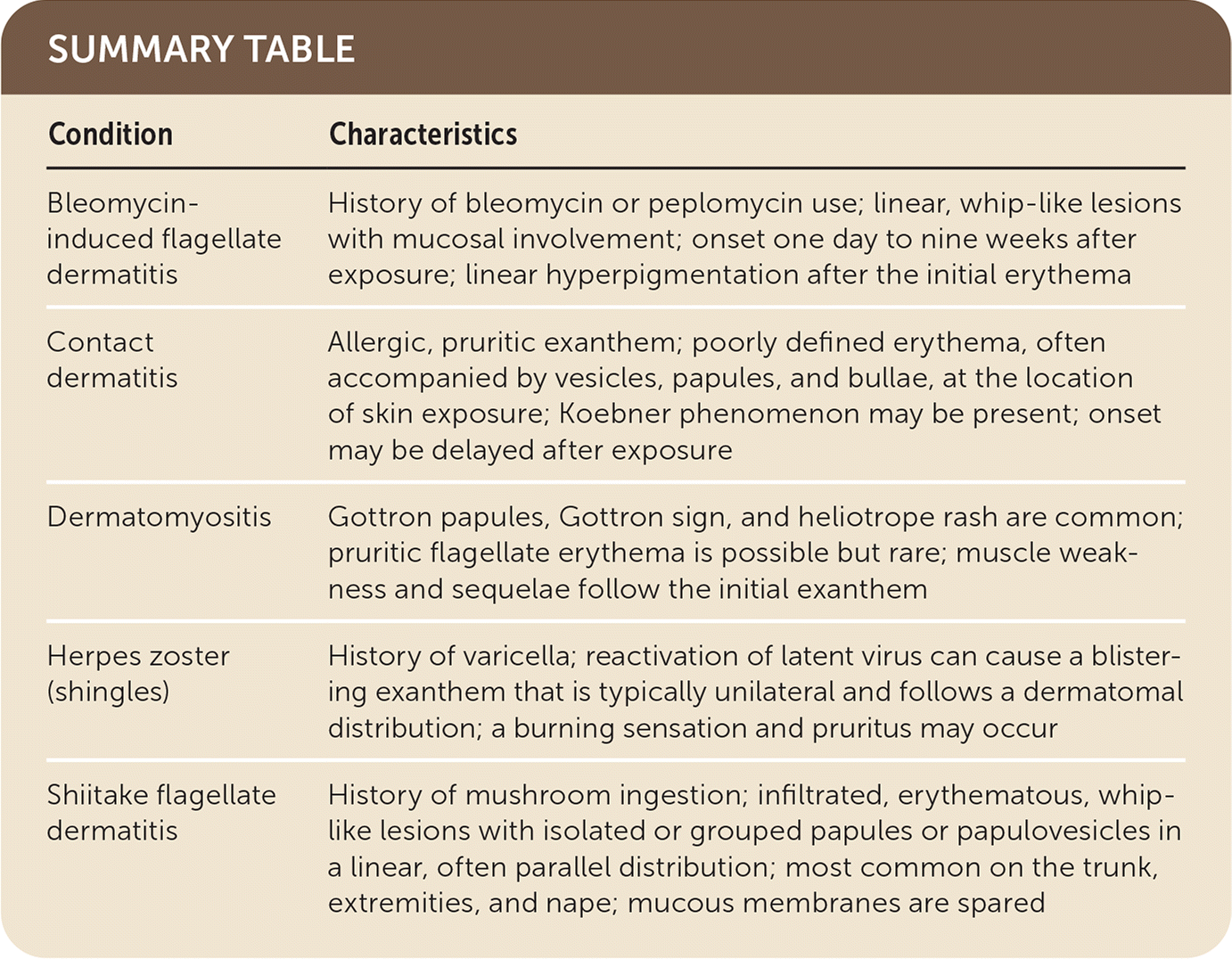
Am Fam Physician. 2021;103(4):243-244
Author disclosure: No relevant financial affiliations.
A 36-year-old patient presented with fever, headache, cough, sore throat, and a new widespread pruritic rash that began 48 hours earlier. The patient had no significant medical or surgical history and was not taking any new medications. The patient had no change in diet, no exposures to chemicals, and no symptomatic contacts.
Examination revealed a maculopapular, erythematous rash with whip-like extensions (Figure 1). The rash was most prominent on the lower abdomen, buttocks, and thighs but extended to the extremities and face, including the vermilion border and eyelids. The rash spared the mucosal surfaces, palms, and soles.

Question
Based on the patient's history and physical examination findings, which one of the following is the most likely diagnosis?
A. Bleomycin-induced flagellate dermatitis.
B. Contact dermatitis.
C. Dermatomyositis.
D. Herpes zoster (shingles).
E. Shiitake flagellate dermatitis.
Discussion
The answer is E: shiitake flagellate dermatitis. The patient revealed that they had consumed raw shiitake mushrooms two days before symptom onset.
Shiitake flagellate dermatitis was first described in susceptible individuals after ingesting raw or undercooked shiitake mushrooms but has more recently been reported with fully cooked mushrooms and with extract.1,2 The exanthem is thought to be secondary to lentinan, a heat-labile protein present in undercooked mushrooms. The exact etiology is unclear, but lentinan is thought to increase secretion of inflammatory cytokine interleukin-1, resulting in vasodilation and hemorrhage.3
The condition develops 24 to 48 hours after consumption of shiitake mushrooms and typically presents as infiltrated, erythematous, whip-like lesions, with isolated or grouped papules or papulovesicles in a linear, often parallel distribution. The rash is usually located on the trunk, extremities, and nape and rarely on the face or scalp; mucous membranes are spared.4,5 The rash is severely pruritic but not painful.6 Koebner phenomenon is not present, and symptoms are not reproduced with scratching. No life-threatening systemic reactions have been documented.1 Symptoms typically regress within days to weeks. Treatment is symptomatic, including antihistamines and topical corticosteroids.4
Bleomycin-induced flagellate dermatitis has a similar distribution to shiitake flagellate dermatitis, but the patient will have a history of treatment with bleomycin (a sulfur-containing chemotherapeutic) or its semisynthetic analogue, peplomycin.3,7,8 Key clinical differences include mucous membrane involvement, onset of exanthema one day to nine weeks after exposure, and linear hyperpigmentation following the initial erythema.3,7–9
Contact dermatitis is an allergic, pruritic exanthem. It presents as poorly defined erythema, often accompanied by vesicles, papules, and bullae, at the location of skin exposure and may have Koebner phenomenon. The exanthem can be delayed up to one week after initial contact, but repeated exposures will cause a more rapid reaction.10
Dermatomyositis is an idiopathic autoimmune myopathy that commonly begins as skin lesions that appear as erythematous to violaceous papules, plaques, and edema over dorsal aspects of bony prominences, such as finger joints (Gottron papules) or elbows and knees (Gottron sign), or over the upper eyelids (heliotrope rash). Pruritic flagellate erythema rarely occurs on the back, chest, or buttocks. Early diagnosis is important because the exanthema typically is followed by muscle weakness and sequelae.11,12
The varicella-zoster virus remains latent in the ganglia after primary infection or vaccination and may be reactivated, causing herpes zoster (shingles). Herpes zoster presents as a blistering exanthem that is typically unilateral and follows a dermatomal distribution. Patients may have a burning sensation and pruritus.13

| Condition | Characteristics |
|---|---|
| Bleomycin-induced flagellate dermatitis | History of bleomycin or peplomycin use; linear, whip-like lesions with mucosal involvement; onset one day to nine weeks after exposure; linear hyperpigmentation after the initial erythema |
| Contact dermatitis | Allergic, pruritic exanthem; poorly defined erythema, often accompanied by vesicles, papules, and bullae, at the location of skin exposure; Koebner phenomenon may be present; onset may be delayed after exposure |
| Dermatomyositis | Gottron papules, Gottron sign, and heliotrope rash are common; pruritic flagellate erythema is possible but rare; muscle weakness and sequelae follow the initial exanthem |
| Herpes zoster (shingles) | History of varicella; reactivation of latent virus can cause a blistering exanthem that is typically unilateral and follows a dermatomal distribution; a burning sensation and pruritus may occur |
| Shiitake flagellate dermatitis | History of mushroom ingestion; infiltrated, erythematous, whiplike lesions with isolated or grouped papules or papulovesicles in a linear, often parallel distribution; most common on the trunk, extremities, and nape; mucous membranes are spared |
The views expressed are those of the authors and do not reflect the official policy or position of the U.S. Army Medical Department or the U.S. Army at large.
